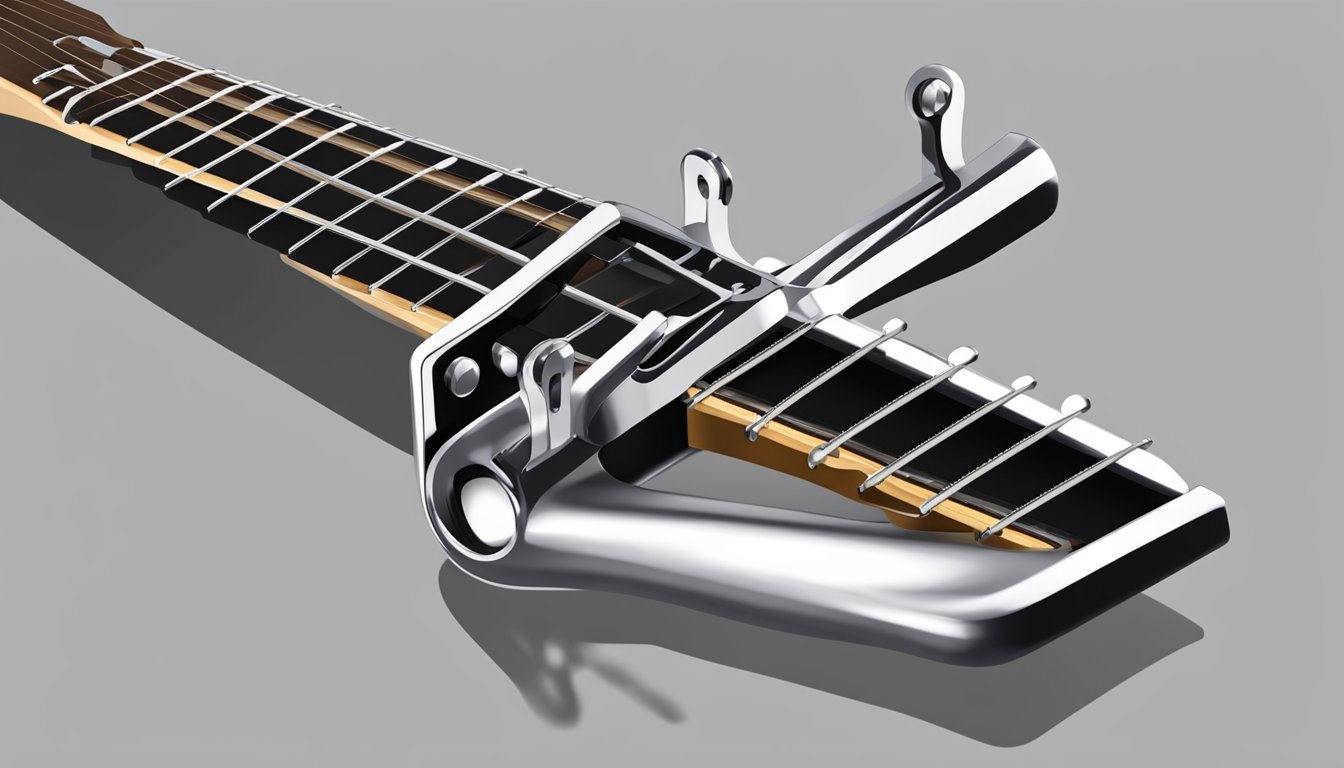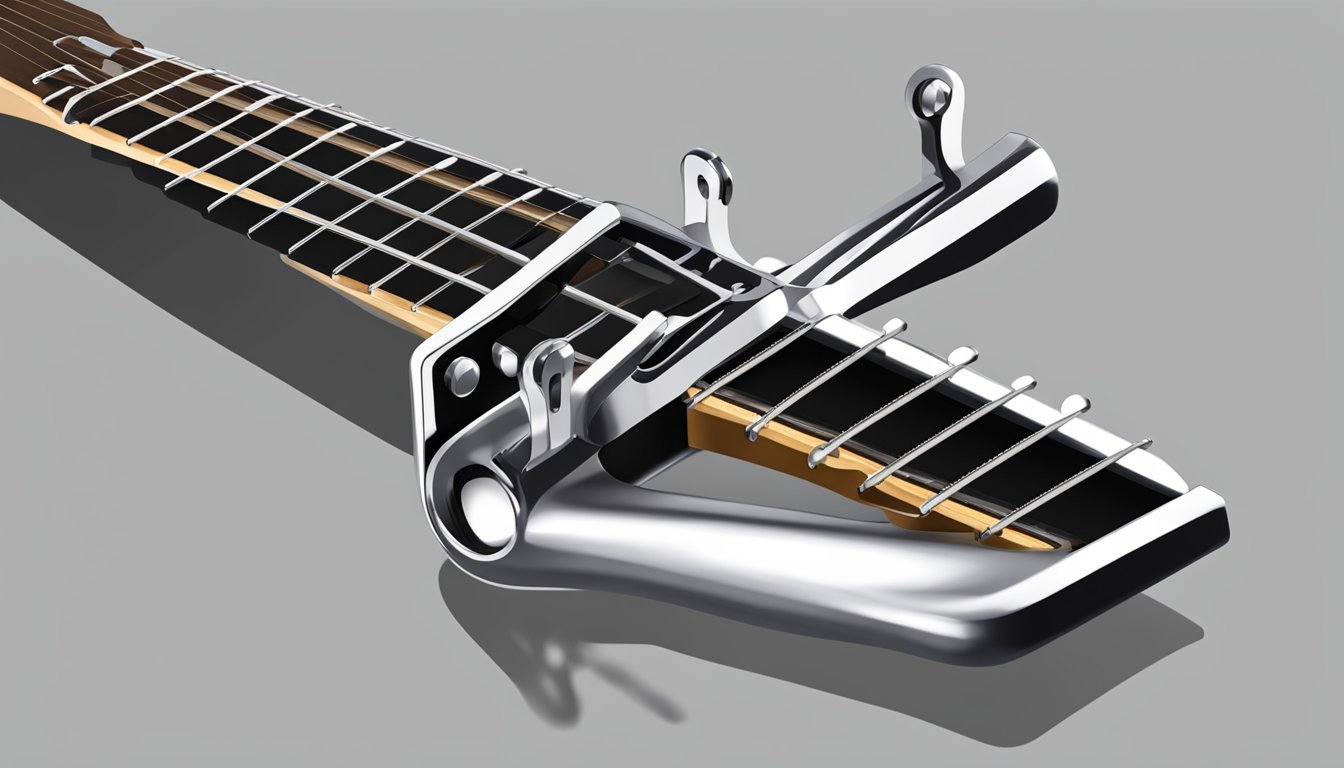A capo is a handy tool for guitar players that can change the key of your music without needing to learn new chord shapes.
You can raise the pitch of the strings by placing a capo on the fretboard.
This allows you to play familiar open chords in different keys.
This simple device opens up a world of possibilities for both beginners and seasoned musicians alike.

Using a capo is easy, and it can transform the way you play.
You can experiment with different positions on the guitar neck to find the perfect sound for your song.
Whether you want to play along with your favorite tracks or create a unique arrangement, a capo can help you achieve that effortlessly.
Get ready to unlock new music experiences as you discover how to use this essential guitar accessory.
From basic applications to more advanced techniques, understanding the capo will enhance your skills and broaden your musical horizons.
Key Takeaways
- A capo changes the pitch of your guitar by altering string length.
- It allows you to play in different keys using familiar chords.
- Understanding the capo can enhance your overall guitar playing experience.
Understanding Capos
A capo is a handy tool for guitar players.
It makes it easier to play in different keys and allows you to use familiar chord shapes.
Let’s break down what a capo is, the different types you can choose from, and the materials they’re made of.
What Is a Guitar Capo?
A guitar capo is a small device that clamps onto the neck of your guitar.
It presses down on all the strings at a specific fret.
This raises the pitch of your guitar, allowing you to play in different keys.
Using a capo can simplify chord progressions, making it easier to play songs in various keys without having to learn new fingerings.
Many musicians find that a capo enhances their creativity by providing fresh sounds to familiar songs.
So, what is a guitar capo? It is an essential tool for guitarists looking to expand their musical possibilities and improve their playing versatility.
Using a capo is popular among beginners and advanced players alike.
It allows you to play songs in a key that suits your voice without learning new chord shapes.
For example, you can play the same chords you know in a higher key, which opens a whole new world of possibilities for your music.
Types of Capos
There are various types of capos you can use depending on your preferences.
Here are some common ones:
-
Trigger Capo: This is the most popular type. It uses a spring mechanism for easy placement and removal. Just squeeze the handle to clamp it on.
-
Toggle Capo: This type uses a lever to apply pressure. It gives you more control over the tension, which can be helpful for delicate fingerings.
-
Partial Capo: A partial capo only covers some strings. This allows for unique tuning options that create different sounds and voicings.
Choose the type that fits your style best, whether you’re playing an acoustic guitar, electric guitar, or classical guitar.
Capo Materials and Build Quality
Capos come in a variety of materials, impacting their durability and ease of use.
Most capos are made from:
-
Metal: These are strong and reliable but can be heavier.
-
Plastic: Lightweight and easy to handle. They may not last as long, but they are often more affordable.
-
Rubber: Some capos have rubber pads to protect your strings and guitar neck from scratches.
When choosing a capo, look for good build quality.
A well-made capo will hold its position securely without buzzing or altering the sound.
Whether you’re strumming an acoustic or jamming on an electric guitar, having the right capo helps make your playing experience better.
Using a Capo on Your Guitar
A capo is a handy tool that helps you change the key of a song without changing your chord shapes.
It’s especially useful for beginner guitarists when playing songs in different keys.
Let’s explore how to use it effectively.
How to Use a Capo
Using a capo is straightforward.
First, decide where you want to place it on the fretboard.
You can place it on any fret, but it’s most common to start around the second or third fret.
To attach the capo, simply press it down across all the strings.
Make sure it’s snug but not too tight—it shouldn’t mute any strings.
Once you have it in place, play your usual chord shapes.
You’ll notice that the pitch of your chords rises as the capo raises the pitch of your strings.
Capo Placement and Technique
Placement is key when using a capo.
The closer to the fret, the better the sound.
If you place it too far back, it might buzz or sound out of tune.
Here are some tips to consider:
- Place your capo just behind the fret for the best sound.
- Avoid placing it directly on the fret or too far back.
- Ensure it’s pressing all strings evenly.
Adjusting the capo technique can also change your playing style.
Experiment with different placements to discover various chord voicings and sounds.
Transposition with a Capo
Transposition is where a capo shines.
It allows you to easily change the key of a song without having to learn new chord shapes.
For example, if a song is in the key of G, placing the capo on the second fret moves it to A.
Here’s a helpful tip: each fret up equals a semitone up.
So, placing the capo on the 1st fret raises everything by one semitone, and on the 2nd fret, it raises it by two.
Using a capo chart can be helpful for understanding these shifts as you play.
Playing Songs with Capo
Many popular songs utilize a capo to simplify playing.
Songs like “Here Comes the Sun” by The Beatles are often played with a capo.
Some easy chords to try:
- Place the capo on the 2nd fret for songs in A major.
- Use the 5th fret for D major songs.
Additionally, you can create different moods by changing the key with a capo.
This gives you more flexibility with the music you can play.
Checking out a guitar capo chart can aid in finding the best placement for the songs you enjoy.
Experiment with these techniques to find what works for you and your playing style!
Advanced Capo Concepts
Using a capo can go beyond just changing the key of a song.
You can explore unique techniques and creative ideas that enhance your guitar playing and songwriting.
Let’s dive into two advanced concepts: partial capos and how songwriters can creatively utilize capos.
Partial Capos and Their Use
A partial capo only covers some of the strings on your guitar.
This technique can create unique chords and voicings.
For example, you can put a partial capo on the second fret, covering the highest four strings while letting the lowest two ring out.
This allows you to play familiar barre chords without needing to fret all the strings.
You can experiment with different string combinations to discover new timbres in your playing.
Guitarists often use this method to give a fresh sound to standard chord progressions.
Many players enjoy using partial capos for specific songs or styles.
This technique can help you create interesting riffs while adding depth to your music.
Creative Applications for Songwriters
Songwriters can benefit greatly from using a capo in innovative ways.
By changing the key easily, you can find the perfect match for a vocalist’s range.
Experimenting with a capo allows you to develop different moods in your songs.
Try using a capo in unusual positions, such as the fourth or fifth fret.
This helps to create brighter sounds and catchier melodies.
You can also combine the capo with open string techniques to craft unique chord progressions.
In addition, consider how you layer your parts.
Use a capo while playing rhythm guitar to create a fuller sound.
Meanwhile, a lead guitarist can play in a different key or register.
This approach can lead to interesting contrasts and engaging compositions.
Using a capo can open up a world of possibilities for your songwriting.
Embrace these advanced concepts and see where they take you!
Frequently Asked Questions
Using a capo can change how you play and sound on the guitar.
It can help with playing songs in different keys and make certain chords easier for you.
Here are some common questions about capos.
How does using a capo affect guitar playing?
When you place a capo on the guitar neck, it raises the pitch of the strings.
This means the open strings sound higher, which can make songs easier to play in different keys.
It’s a handy tool for changing the song’s feel without complex fingerings.
Can beginners benefit from using a capo on their guitar?
Yes, beginners can use a capo to play along with songs that may be too tricky without it.
It allows you to play simple chord shapes while still matching the song’s original key, making practice more enjoyable.
What’s the deal with capos and changing keys on the guitar?
A capo effectively moves the nut of your guitar up the neck.
By placing it on different frets, you can play in any key without changing your finger positions.
This lets you explore various musical styles easily.
How does a capo impact the chords you play on a guitar?
Using a capo changes the names of the chords you play.
For example, if you play an “A” shape with the capo on the second fret, it sounds like a “B” chord.
This shifting helps you play different chord progressions quickly.
Is it essential to use a capo when playing the guitar?
It’s not essential, but it can be very helpful.
Many guitarists use it for convenience or to fit their vocal range.
If you want to play along with recordings or make certain songs easier, a capo is a great choice.
Why would you choose a capo over altering your guitar’s tuning?
Using a capo is simpler and quicker than retuning the guitar.
It allows you to play in various keys without the hassle of adjusting your strings every time you want to change the sound.
This makes it a favorite for many guitar players.

